Gentiana autumnalis, pinebarren gentian, is an awesomely beautiful showy native perennial herbaceous plant. It is rare and in NJ it is only found in the Pine Barrens. It is an early successional plant and is one of the last blooming plant in the fall, blooming September to October.
Most of the information presented here is from Dr. Ryan Rebozo's doctoral dissertation (2015) which is a study of the effect of management on pine barren gentian. However, there is also extensive information about the natural history of the pinebarren gentian in the dissertation. Some of that information is presented here.
Flowers
Inflorescence/Flower cluster:
 In Gentiana autumnalis, the flower is generally solitary on the top of a tall stem facing upwards. Sometimes the upper stem branches, each branch with a terminal flower.
In Gentiana autumnalis, the flower is generally solitary on the top of a tall stem facing upwards. Sometimes the upper stem branches, each branch with a terminal flower.
Individual Flower:
The pinebarren gentian flowers are stunning azure blue to purple but occasionally white and pale pink flowers have been observed. The tubular corolla flares usually into 5 prominent lobes; flowers have been found with 3 or 4 lobes. The lobes are spotted and the margins are smooth. In between the lobes, are floral appendages that are fringed and are lot shorter than the lobes. The floral appendages are frequently referred to as folds, plaits, pleats or secondary lobes. The relative heights/lengths of the lobes and plaits are used to distinguish between the gentian species. The pinebarren gentian flower is about 2 inches long. The calyx/sepals lobes are narrow and about 1 inch long.
The corolla inner surface is whitish. The lobes and insides are sprinkled with dots and stripes which act as nectar guides leading the pollinator deep into the base of the flower. The nectaries are located at the base of the ovary. The flowers close before dark and do not open during heavy cloud cover. This conserves pollen and nectar.
The flower has 5 petals, 5 stamens and 5 sepals. It has a single style that opens into 2 stigmas.
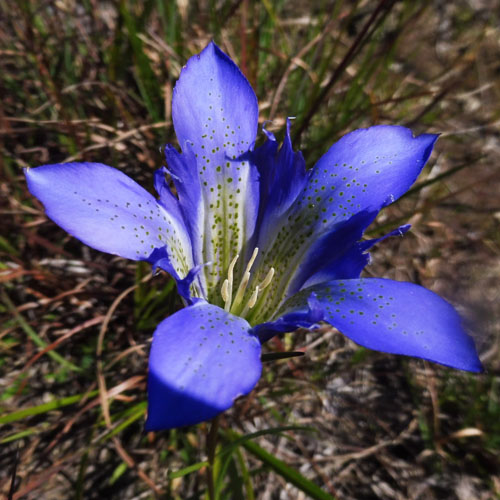
The plaits/folds are not spotted and the fringes can clearly be seen.
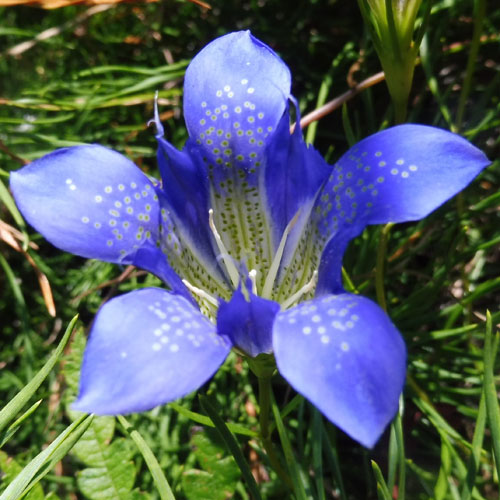
The outer surface of the corolla is tan for the lobes and blue for the plaits. The caylx is green and the 5 sepals are long, narrow and sharply pointed.
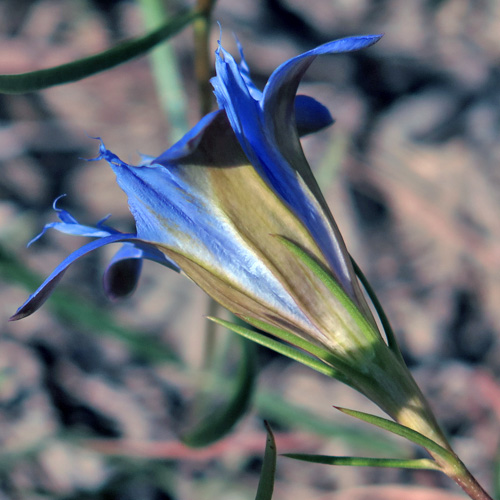
A closer look at the pistil and stamens of the flower: The pinebarren gentian flower exhibits protandry meaning that it's stamen matures (pollen ready) before the pistil matures (stigma receptive). Generally this encourages cross pollination and discourages self pollination. In a population, the flowers bloom asynchronously. In the studied areas, peak flowering occurred in the third week of September.

When the flower opens the stamens are ready.
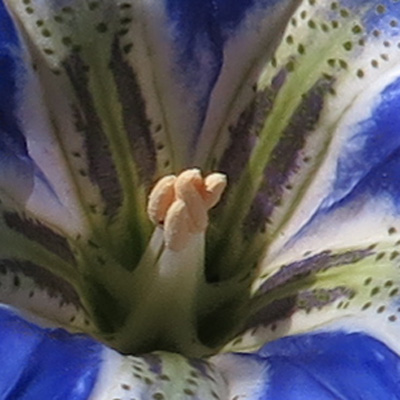
While the stamens are still functional and the pistil is not yet mature, the flower is considered to be the male (staminate) phase. The flowers remain in this phase about 6 days.
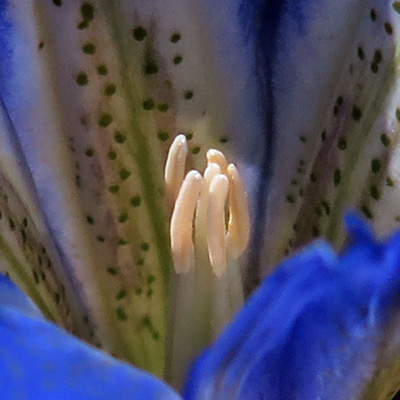
There is a transitional phase where the anthers have no more pollen and the stigma is not yet receptive. A flower would be in this stage for about 3 days. In a population, there can be a signicant percentage of the plants in this phase.
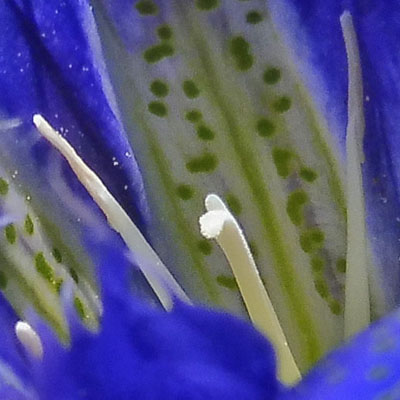
This is the pistillate phase. The stigma is receptive and the anthers are depleted. The flower remains in this phase for an average of 14 days. The duration of this phase depends on how quickly the flower gets pollinated. Hand pollinated flowers close in a day. The fact that the flower remains in the pistillate phase so long suggests that there is not enough pollen and/or insects for pollination.

Pollination and fertilization is completed. The stigma is shriveled and the ovary is expanding and the anthers are shriveled up too.

Pollination
Pinebarren gentian provides only a little nectar to reward pollinators which are mainly flies. With protandry, the relative number of plants in the staminate, transition, and pistillate phases vary during the reproductive season.
The number of flowering plants peaks the third week in September. The gentian insect visitation rate was significantly greater in the last three weeks of October when compared to the first five weeks of gentian flowering. So peak flowering did not coincide with peak pollinator visitations. Peak insect visitation to the gentians occurred after other non-gentian plants stopped flowering. Insects appeared to prefer visiting the flowers of other plants. Staminate gentian flowers were visited more than pistillate flowers. Morning visitation was significantly greater than afternoon insect visitation.
Pinebarren gentian provides only a little nectar to reward pollinators. Available nectar was greatest between the third and fourth week of September. These weeks coincide with peak flowering. Nectar volume was significantly greater in the staminate stage than the other two stages. So staminate flowers would be more attractive to insects and also pollen would be an added reward. It takes more than 4 hours to replenish the nectar to a substantial amount so most likely less nectar would be available during the afternoon resulting in fewer insect visits in the afternoon.
Bud & 4 Petal flower
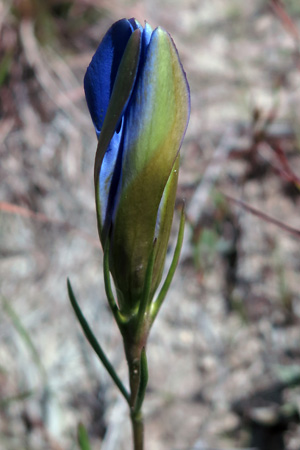
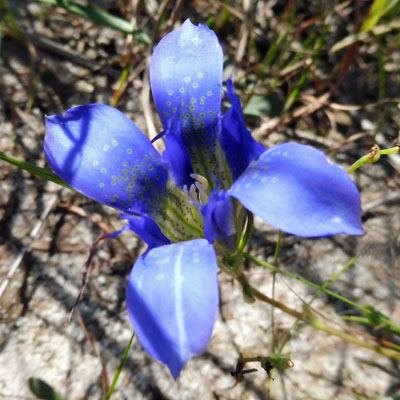
Plant - Leaves - Habitat
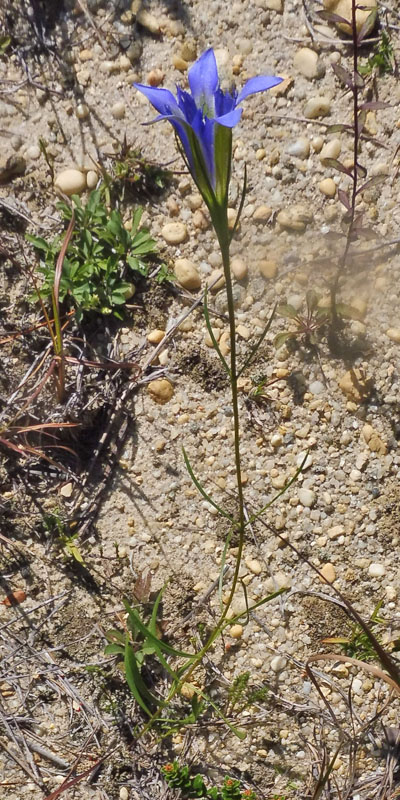 The pinebarren gentian plant is usually a single stem from 6 inches to 2 feet tall with narrow opposite leaves. Generally each stem has a single flower, but occasionally 2-3 flowers per stem. Multiple stemmed individuals are not uncommon in the species, with up to 15 stems emerging from a single root stock.
The pinebarren gentian plant is usually a single stem from 6 inches to 2 feet tall with narrow opposite leaves. Generally each stem has a single flower, but occasionally 2-3 flowers per stem. Multiple stemmed individuals are not uncommon in the species, with up to 15 stems emerging from a single root stock.
The leaves are opposite, linear (narrow), 1 to 3 inches long. The margins are smooth and the leaf is not hairy.

The pinebarren gentian life cycle is described as 4 stages: seed, seedling (first year), vegetative plants (second year or older without flowers), and flowering plants. Most population in NJ are small and have few plants which on average only 27% of them are in the flowering stage. With usually only one flower per plant, cross pollination is limited. Interestingly, the vegetative plants are frequently the dominant plant type in a population. Studies showed that about only 60% of flowering individuals flowered in successive years while the remaining reverted back to a vegetative state for at least one year before flowering again. The number of seedlings were low at most sites. Also it was found that the plant can remain dormant (no above ground growth) for at least one year to wait for favorable growing conditions.
Habitat: Pinebarren gentian preferentially grows in open habitats and moist sandy soil of the Pine barrens. The Pine Barren ecosystem is fire dependent and the soil is both acidic and offers little to sustain life. The roots of Gentiana autumnalis are thick and fibrous, typically bifurcated with few fine roots. The presence of arbuscular mycorrhizal fungi was found. The plant would provide carbon to the fungus in exchange of inorganic nutrients from the fungi. The percentage of gentian root colonized by mycorrhizal fungi averaged 85%.
The habitat includes sandy, open areas; moist open woods; roadsides; bogs; swamps; and moist coastal plain pine barrens.
Gentiana autumnalis, pinebarren gentian, is in New Jersey's "List of Endangered Plant Species and Plant Species of Concern, May 2022" as G3S3
This plant, in its flowering stage, has a huge flower with few very narrow leaves to collect sunlight. The plant also grows in inhospital soil so having a prolonged vegetatiive stage certainly helps for storage of food for the flowering stage. Its reproductive strategy does not appear to be promote prolific populations and the plants are very vulnerable to succession. These factors make survival difficult.
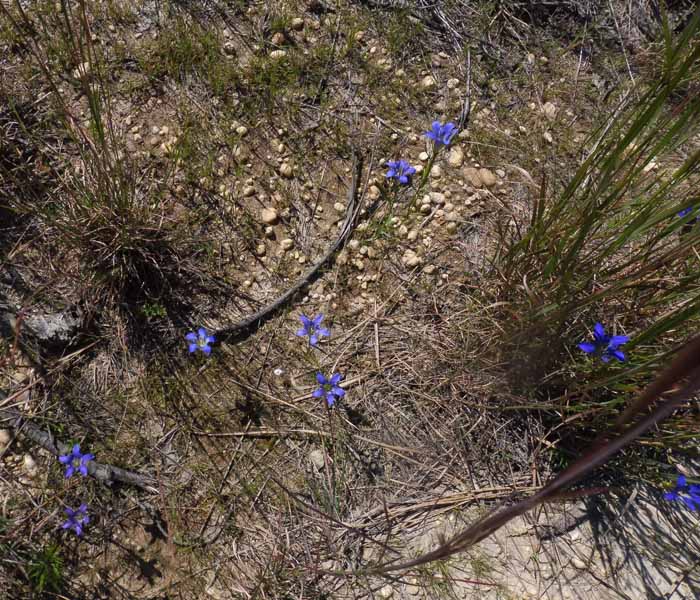
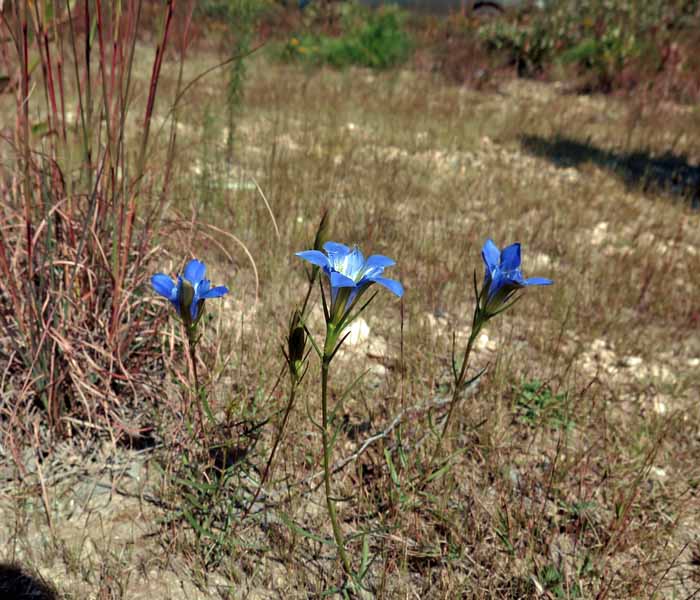
Text by Millie Ling and all photos by Hubert & Millie Ling. Photos: September 2017. We have seen this plant at only two locations: Warren Grove National Guard Bombing Range in Warren Grove on a special field trip with the Philadelphia Botanical Club led by Ryan Rebozo and at the New Jersey Conservation Foundation’s Franklin Parker Preserve in Chatsworth, both in the Pine Barrens.
Additional information
Additional information / references:
- The USDA website shows Gentiana autumnalis distribution in the US and other information: https://plants.sc.egov.usda.gov/home/plantProfile?symbol=GEAU4
- As mentioned above, most of the information presented came from Dr. Ryan R. Rebozo's Doctoral dissertation (2015): 'The Influence of Land Management on the Demography of the Pine Barren gentian (Gentiana autumnalis) in New Jersey'.
- 'Gentiana autumnalis' https://plants.ces.ncsu.edu/plants/gentiana-autumnalis/
- Most of the articles I have seen on the internet reference back to articles written by Dr. Ryan R. Rebozo